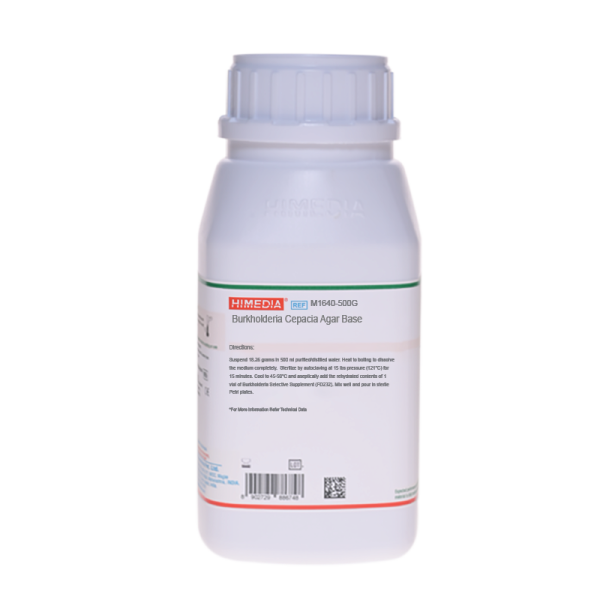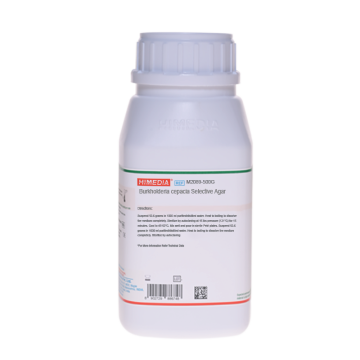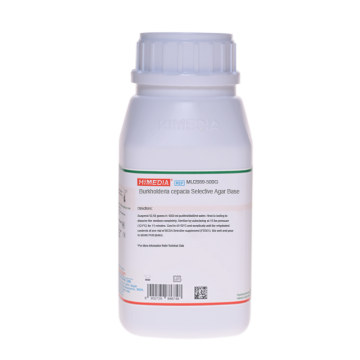 Your enquiry has been submitted
Your enquiry has been submitted
Burkholderia Cepacia Agar Base
Intended Use
Recommended as a selective medium used for isolation of Burkholderia cepacia from the respiratory secretions of patients with cystic fibrosis and other non-clinical specimens.
Composition**
| Ingredients | g / L |
|---|---|
| Peptone | 5.000 |
| Yeast extract | 4.000 |
| Sodium pyruvate | 7.000 |
| Potassium dihydrogen phosphate | 4.400 |
| Disodium hydrogen phosphate | 1.400 |
| Bile salts | 1.500 |
| Ammonium sulphate | 1.000 |
| Magnesium sulphate | 0.200 |
| Ammonium ferrous sulphate | 0.010 |
| Phenol red | 0.020 |
| Crystal violet | 0.001 |
| Agar | 12.000 |
Final pH ( at 25°C): 6.2±0.2
**Formula adjusted, standardized to suit performance parameters
Directions
Suspend 18.26 grams in 500 ml purified/distilled water. Heat to boiling to dissolve the medium completely. Sterilize by autoclaving at 15 lbs pressure (121°C) for 15 minutes. Cool to 45-50°C and aseptically add the rehydrated contents of 1 vial of PGT Selective Supplement (FD232). Mix well and pour in sterile Petri plates.
Principle And Interpretation
Burkholderia cepacia is an important opportunistic pathogen and causes pulmonary infection among individuals with cystic fibrosis (CF). The organism may lead to Burkholderia cepacia syndrome, a neutralizing pneumonia associated with fever that culminates in to a rapid and fatal clinical deterioration (1). B. cepacia is difficult to isolate on routinely used laboratory media like MacConkey Agar, since B.cepacia is a slow grower and therefore it is usually outgrown by the faster growing Escherichia coli, Staphylococcus aureus and Pseudomonas aeruginosa. Burkholderia Cepacia Agar is based on PC medium, which was originally devised by Gilligan (2). This medium was found to be superior to MacConkey Agar for growth of B. cepacia. The medium is made selective for B. cepacia by the incorporation of bile salts, crystal violet and antibiotics. The antibiotics included are Polymyxin B, Gentamycin, Ticarcillin in the form of freeze dried supplement (FD).
Peptone and yeast extract in the medium provides the nitrogenous, vitamin B source and other essential nutrients. Crystal violet, bile salts and antimicrobial agents are used as selective agents. Crystal violet and bile salts inhibits gram-positive cocci including Enterococci and Staphylococci. The antibiotics (FD) namely ticarcillin, polymyxin B and gentamycin inhibit gram-negative bacteria. B.cepacia metabolizes pyruvate forming alkaline end products. These end products elevate the pH of the medium. The phenol red indicator changes colour from pink orange to pink red in alkaline pH.
Inoculate the plate with the specimen so as to obtain isolated colonies. The plates should be incubated for a period of 4 days to allow B.cepacia to grow and form colonies and subsequent colour change (2,3). The medium is not selective only for B.cepacia. Other organisms forming similar colonies may also grow on this medium. Therefore results obtained on this media should not be the sole criteria for identification of B.cepacia (4).
Type of specimen
Clinical samples - Throat, body fluids, etc.
Specimen Collection and Handling
For clinical samples follow appropriate techniques for handling specimens as per established guidelines (5,6). After use, contaminated materials must be sterilized by autoclaving before discarding.
Warning and Precautions
In Vitro diagnostic use only. For professional use only. Read the label before opening the container. Wear protective gloves/protective clothing/eye protection/ face protection. Follow good microbiological lab practices while handling specimens and culture. Standard precautions as per established guidelines should be followed while handling clinical specimens. Safety guidelines may be referred in individual safety data sheets.
Limitations
- Individual organisms differ in their growth requirement and may show variable growth patterns on the medium.
- Each lot of the medium has been tested for the organisms specified on the COA. It is recommended to users to validate the medium for any specific microorganism other than mentioned in the COA based on the user’s unique requirement.
- Further biochemical tests must be carried out for confirmation.
Performance and Evaluation
Performance of the medium is expected when used as per the direction on the label within the expiry period when stored at recommended temperature.
Quality Control
Appearance: Light yellow to pink homogeneous free flowing powder
Gelling: Firm, comparable with 1.2% Agar gel.
Colour and Clarity of prepared medium: Orange coloured clear to slightly opalescent gel forms in Petri plates
Reaction: Reaction of 3.65% w/v aqueous solution at 25°C. pH : 6.2±0.2
pH: 6.00-6.40
Cultural Response
Cultural characteristics observed, with addition of PGT Selective Supplement (FD232), after an incubation at 35-37°C for 48-72 hours.
| Organism | Inoculum (CFU) | Growth | Recovery | Colour of colony |
|---|---|---|---|---|
| Burkholderia cepacia ATCC 25608 | 50-100 | good-luxuriant | >=50% | sage green colonies with bright pink medium |
| ^Pseudomonas paraeruginosa ATCC 9027 (00026*) | >=104 | inhibited | 0% |
Key : (*) - Corresponding WDCM numbers ^ Formerly known as Pseudomonas aeruginosa
Storage and Shelf Life
Store between 10-30°C in a tightly closed container and the prepared medium at 2-8°C. Use before expiry date on the label. On opening, product should be properly stored dry, after tightly capping the bottle in order to prevent lump formation due to the hygroscopic nature of the product. Improper storage of the product may lead to lump formation. Store in dry ventilated area protected from extremes of temperature and sources of ignition Seal the container tightly after use. Product performance is best if used within stated expiry period.
Disposal
User must ensure safe disposal by autoclaving and/or incineration of used or unusable preparations of this product. Follow established laboratory procedures in disposing of infectious materials and material that comes into contact with clinical sample must be decontaminated and disposed of in accordance with current laboratory techniques (5,6).
Reference
- Whitby P. W., 1998, J. Clin. Microbiol., 36:1642 1645
- Gilligan, 1996. Clin. Microbiol. Newsl. 18:8
- MacDonald Gilligan, Welch, Reller and Menegus, 1994, Vol. 5:1, Cystic Fibrosis Foundation, Washington, D.C.
- Christensen et al, 1980, J. Clin. Microbiol., 27:27
- Isenberg, H.D. Clinical Microbiology Procedures Handbook. 2nd Edition.
- Jorgensen, J.H., Pfaller, M.A., Carroll, K.C., Funke, G., Landry, M.L., Richter, S.S and Warnock., D.W.(2015) Manual of Clinical Microbiology, 11th Edition. Vol. 1.
| Product Name | Burkholderia Cepacia Agar Base |
|---|---|
| SKU | M1640 |
| Product Type | Regular |
| Physical Form | Powder |
| Origin | Animal |
| Packaging type | HDPE |
| References | 1.Christensen et al, 1980, J. Clin. Microbiol., 27:270 2.Gilligar, Gage, Bradshaw, schidlow and Deciscco, 1985, J. Clin. Microbiol., 22: |
| Customized Product Available | No |








